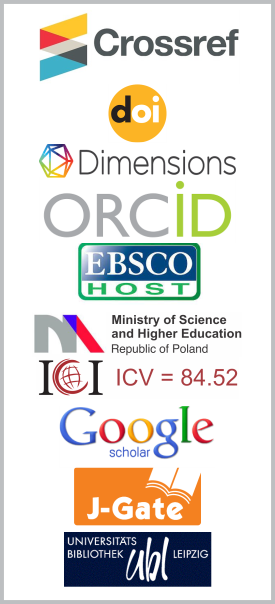Constructing Recursive MDS Matrices Effective for Implementation from Reed-Solomon Codes and Preserving the Recursive Property of MDS Matrix of Scalar Multiplication
DOI:
https://doi.org/10.26713/jims.v11i2.957Keywords:
MDS matrix, Recursive MDS matrices, RS codesAbstract
MDS matrices from Maximum Distance Separable codes (MDS codes) and MDS matrix transformations have important applications in cryptography. However, MDS matrices always have a large description and cannot be sparse, causing costly hardware/software implementations. Recursive MDS matrices allow to solve this problem as they can be a power of a simple serial matrix, so there is a compact description suitable even for constrained processing environments. In this paper, the method for constructing recursive MDS matrices effective for implementation from Reed-Solomon codes is presented. In addition, preserving the recursive property of MDS matrix of scalar multiplication transformation is given. The recursive MDS matrices effective for implementation are meaningful in hardware implementation, and the ability to preserve recursive property of MDS matrix of scalar multiplication transformation also has important applications for efficiently building dynamic block ciphers to improve the security of block ciphers.
Downloads
References
D. Augot and M. Finiasz, Direct construction of recursive MDS diffusion layers using shortened BCH codes, 21st International Workshop on Fast Software Encryption, FSE 2014, Springer (2014), DOI: 10.1007/978-3-662-46706-0_1.
D. Augot and M. Finiasz, Exhaustive search for small dimension recursive MDS diffusion layers for block ciphers and hash functions, in 2013 IEEE International Symposium on Information Theory Proceedings (ISIT), IEEE (2013), pp. 1551 – 1555, DOI: 10.1109/ISIT.2013.6620487.
K. C. Gupta and I. G. Ray, On Constructions of MDS Matrices from Companion Matrices for Lightweight Cryptography, Applied Statistics Unit, Indian Statistical Institute 203, B. T. Road, Kolkata 700108, India (2013), https://link.springer.com/content/pdf/10.1007/978-3-642-40588-4_3.pdf.
K. C. Gupta and I. G. Ray, On constructions of MDS matrices from circulant-like matrices for lightweight cryptography, Technical Report No. ASU/2014/1, dated: 14th February, 2014, https://www.isical.ac.in/~asu/TR/TechRepASU201401.pdf.
L. Keliher, Linear Cryptanalysis of Substitution-Permutation Networks, Queen's University, Kingston, Ontario, Canada (2003), http://www.madchat.fr/crypto/codebreakers/keliherPhD.pdf.
S. Kolay and D. Mukhopadhyay, Lightweight diffusion layer from the kth root of the MDS matrix, IACR Cryptology ePrint Archive 498 (2014), https://eprint.iacr.org/2014/498.pdf.
T. T. Luong and N. N. Cuong, Direct exponent and scalar multiplication transformations of MDS matrices: some good cryptographic results for dynamic diffusion, Journal of Computer Science and Cybernetics 32 (1) (2016), 1 – 17, DOI: 1813-9663/32/1/7732.
T. T. Luong, Constructing effectively MDS and recursive MDS matrices by Reed-Solomon codes, Journal of Science and Technology on Information Security of Viet Nam Government Information Security Commission, 3(2) (2016), 10 – 16, http://antoanthongtin.vn/Portals/0/NewsAttach/2017/01/MDS%20matric.pdf.
F. J. MacWilliams and N. J. A. Sloane, The Theory of Error-Correcting Codes, (Bell Laboratories, Murray Hill, NJ, USA), North-Holland Publishing Company, Amsterdam, pp. 100 – 350, New York, Oxford (1977), http://www.academia.edu/download/43668701/linear_codes.pdf.
G. Murtaza and N. Ikram, Direct Exponent and Scalar Multiplication Classes of an MDS Matrix, [EB/OL], National University of Sciences and Technology, Pakistan, (2011-01-10), pp. 2 – 5, http://citeseerx.ist.psu.edu/viewdoc/download?doi=10.1.1.400.8450&rep=rep1&type=pdf.
M. Sajadieh, M. Dakhilalian, H. Mala and P. Sepehrdad, Recursive diffusion layers for block ciphers and hash functions, in Fast Software Encryption, Springer (2012), pp. 385 – 401, DOI: 10.1007/978-3-642-34047-5_22.
C. Schnorr and S. Vaudenay, Black box cryptanalysis of hash networks based on multipermutations, in Advances in Cryptology - EU-ROCRYPT '94.Proceedings, A. De Santis (editor), Vol. 950 of LNCS, pp. 47 – 57, Springer-Verlag (1995), DOI: 10.1007/BFb0053423.
S. Vaudenay, On the need for multipermutations: cryptanalysis of MD4 and SAFER, in Fast Software Encryption.Proceedings, B. Preneel (editor), Vol. 1008 of LNCS, pp. 286 – 297, Springer-Verlag (1995), DOI: 10.1007/3-540-60590-8_22.
S. Wu, M. Wang and W. Wu, Recursive diffusion layers for (lightweight) block ciphers and hash functions, in Selected Areas in Cryptography, Springer (2013), pp. 43 – 60, http://ir.iscas.ac.cn/handle/311060/15899.
M. R. Z'aba, Analysis of Linear Relationships in Block Ciphers, Ph.D Thesis, Queensland University of Technology, Brisbane, Australia (2010), http://eprints.qut.edu.au/35725/1/Muhammad_Z%27aba_Thesis.pdf.
Downloads
Published
How to Cite
Issue
Section
License
Authors who publish with this journal agree to the following terms:- Authors retain copyright and grant the journal right of first publication with the work simultaneously licensed under a CCAL that allows others to share the work with an acknowledgement of the work's authorship and initial publication in this journal.
- Authors are able to enter into separate, additional contractual arrangements for the non-exclusive distribution of the journal's published version of the work (e.g., post it to an institutional repository or publish it in a book), with an acknowledgement of its initial publication in this journal.
- Authors are permitted and encouraged to post their work online (e.g., in institutional repositories or on their website) prior to and during the submission process, as it can lead to productive exchanges, as well as earlier and greater citation of published work.




